Spinning
The Secret to Ultimate Customization? Handspun Yarn Structures
Spinning your own yarn opens up a world of customization for fiber artists and crafters. Not only can you spin any fiber or color you can imagine, you can also create a variety of yarn structures from the ground up. Even if you’re not a hand spinner, it’s useful to learn how different types of yarn are made and how the structure can impact your finished creations. Here are some of the most common yarn structures and how they’re made!
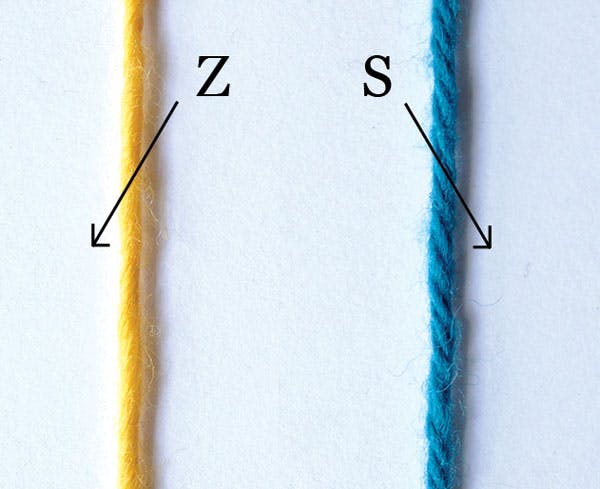

What is twist direction?
You might have heard of yarns having an Z or S twist, but what does that mean? Z-twist means that when you look at a strand of yarn held vertically, the fibers slant to the right, like the direction of the center stroke of the letter “Z”. S-twist is the opposite, and the fibers slant up to the left like the center of the letter “S”.
Most singles are spun with Z-twist, with the drive wheel or spindle turning clockwise. When plying, you’ll spin with the wheel or turning counterclockwise, so the finished yarn has an S-twist. Of course, there’s no reason why you can’t spin your singles with S-twist and ply with Z-twist; give both a try and see how they compare.
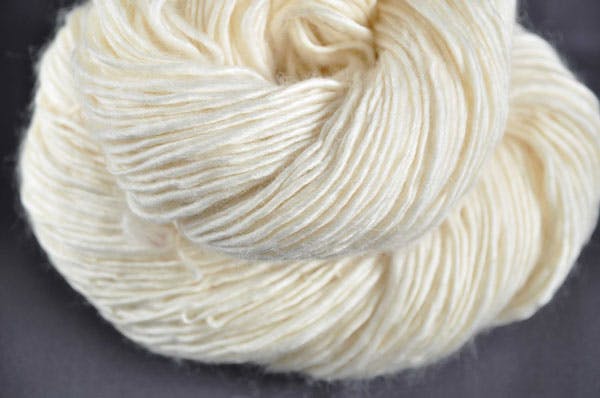

Soft singles yarn.
Singles
Singles are the basic unit of handspun yarn. They’re the first thing you learn to spin and can be used on their own or plied to produce a thicker yarn. A single can be spun in either direction (S or Z), and the amount of twist that is added can produce a variety of effects.
A small amount of twist, just enough to hold the fibers together, will result in a soft, lofty yarn that can be knitted with on its own. Singles take the least amount of time to spin up, since the finished thickness is produced in a single step. Multi-colored fiber looks great as a low-twist single, since it keeps the colors clear and distinct, but soft singles are generally less durable than plied yarns.
More twist can make your singles stronger and sturdier, but be careful not to add too much. Too much twist in a single can cause plain knitted fabrics to bias or skew, but this can often be countered by avoiding , instead opting for textured knit and purl patterns. It takes practice to produce singles yarns that are twisted enough to be durable, but not overtwisted.
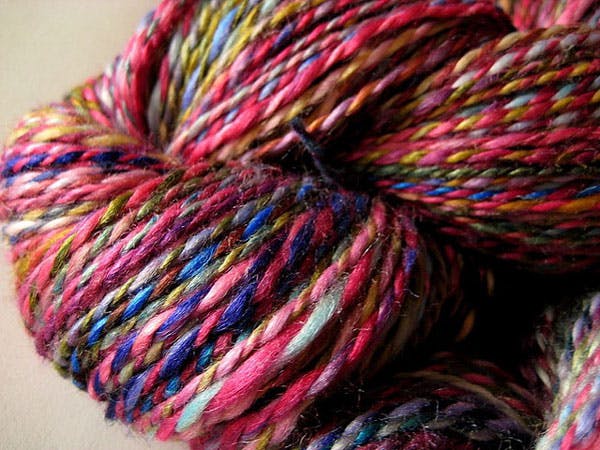

Two-ply yarn spun from multicolored fiber.
Plying
Plying is the process of twisting two or more singles of yarn together to produce a finished yarn. Plied yarns are more durable than singles, and usually more balanced. When the yarn doesn’t twist in either direction after washing and finishing, and knits up into a flat, non-biasing fabric, the yarn is said to be balanced.
With some fibers, spinning thinner singles then plying them together to get a thicker strand gives better results than spinning thicker singles all in one step. Plying removes a bit of twist and can even out inconsistencies in the thickness, as the differences are distributed and averaged out over the finished yarn. The downside of plying? It does take significantly work to produce the same finished yardage as a single!
Two-ply
Two-ply yarns can be produced in a variety of ways. Basic plying consists of two separate singles, which are plied together in the opposite direction from the singles. Andean plying, a method of winding yarn around your hand, allows you to make a two-ply from pulling on each end of one bobbin of singles.
In a two-ply yarn, the two singles are a bit at odds with each other, as they want to pull in opposite directions. This is especially good for , as this characteristic helps yarn overs “open up” and create negative space, moreso than three-ply yarns.
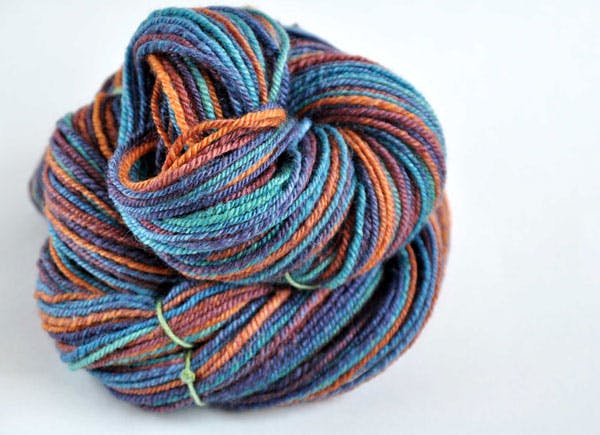

Chain plied yarn preserves long color runs.
Three-ply
Three-ply yarns can also be spun using the basic plying method: joining three singles together and spinning in the opposite direction. Three-plies are even stronger than two, and the resulting yarn feels plump and round. This is great for stitch definition in texture patterns and cables, as the three-plies fill in the fabric for a cohesive look.
A single can also be plied into a three-ply yarn using the chain method (also called Navajo plying). Chain plying uses only one ball or bobbin of singles, and employs a simple looping method that is basically a crochet chain using your hands. Chain plying preserves long color runs, perfect for creating self-striping yarns and since you’re only working from one bobbin, there are never any leftover singles.
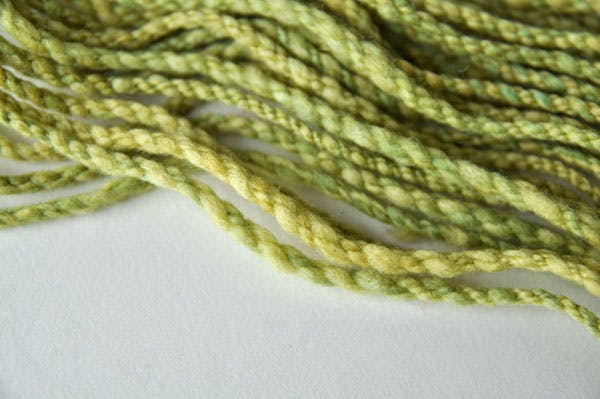

Cabled yarn has a unique and beautiful look.
Four-ply and cabled yarns
Four (or more) plies in a handspun yarn is a test of endurance! It takes a lot of work to produce a four-ply yarn of the same length as a single or two-ply. But the resulting yarn is again even more round than three-ply, for fantastic stitch definition and durability. Cabled yarn is also a four-ply yarn, but constructed slightly differently: first you produce two two-ply yarns, then ply the two two-ply strands together in the opposite direction once again, to produce the finished cabled yarn. As you can image, this is a long and laborious undertaking, but the resulting yarn is beautiful, strong and will last a lifetime.
[box type=”shadow”]Practice the ancient art of spindling! Learn to card natural fibers and create stunning yarns in a variety of textures, all on a portable drop spindle in the online Bluprint class .[/box]The Secret to Ultimate Customization? Handspun Yarn Structures
Spinning your own yarn opens up a world of customization for fiber artists and crafters. Not only can you spin any fiber or color you can imagine, you can also create a variety of yarn structures from the ground up. Even if you’re not a hand spinner, it’s useful to learn how different types of yarn are made and how the structure can impact your finished creations. Here are some of the most common yarn structures and how they’re made!


What is twist direction?
You might have heard of yarns having an Z or S twist, but what does that mean? Z-twist means that when you look at a strand of yarn held vertically, the fibers slant to the right, like the direction of the center stroke of the letter “Z”. S-twist is the opposite, and the fibers slant up to the left like the center of the letter “S”.
Most singles are spun with Z-twist, with the drive wheel or spindle turning clockwise. When plying, you’ll spin with the wheel or turning counterclockwise, so the finished yarn has an S-twist. Of course, there’s no reason why you can’t spin your singles with S-twist and ply with Z-twist; give both a try and see how they compare.


Soft singles yarn.
Singles
Singles are the basic unit of handspun yarn. They’re the first thing you learn to spin and can be used on their own or plied to produce a thicker yarn. A single can be spun in either direction (S or Z), and the amount of twist that is added can produce a variety of effects.
A small amount of twist, just enough to hold the fibers together, will result in a soft, lofty yarn that can be knitted with on its own. Singles take the least amount of time to spin up, since the finished thickness is produced in a single step. Multi-colored fiber looks great as a low-twist single, since it keeps the colors clear and distinct, but soft singles are generally less durable than plied yarns.
More twist can make your singles stronger and sturdier, but be careful not to add too much. Too much twist in a single can cause plain knitted fabrics to bias or skew, but this can often be countered by avoiding , instead opting for textured knit and purl patterns. It takes practice to produce singles yarns that are twisted enough to be durable, but not overtwisted.


Two-ply yarn spun from multicolored fiber.
Plying
Plying is the process of twisting two or more singles of yarn together to produce a finished yarn. Plied yarns are more durable than singles, and usually more balanced. When the yarn doesn’t twist in either direction after washing and finishing, and knits up into a flat, non-biasing fabric, the yarn is said to be balanced.
With some fibers, spinning thinner singles then plying them together to get a thicker strand gives better results than spinning thicker singles all in one step. Plying removes a bit of twist and can even out inconsistencies in the thickness, as the differences are distributed and averaged out over the finished yarn. The downside of plying? It does take significantly work to produce the same finished yardage as a single!
Two-ply
Two-ply yarns can be produced in a variety of ways. Basic plying consists of two separate singles, which are plied together in the opposite direction from the singles. Andean plying, a method of winding yarn around your hand, allows you to make a two-ply from pulling on each end of one bobbin of singles.
In a two-ply yarn, the two singles are a bit at odds with each other, as they want to pull in opposite directions. This is especially good for , as this characteristic helps yarn overs “open up” and create negative space, moreso than three-ply yarns.


Chain plied yarn preserves long color runs.
Three-ply
Three-ply yarns can also be spun using the basic plying method: joining three singles together and spinning in the opposite direction. Three-plies are even stronger than two, and the resulting yarn feels plump and round. This is great for stitch definition in texture patterns and cables, as the three-plies fill in the fabric for a cohesive look.
A single can also be plied into a three-ply yarn using the chain method (also called Navajo plying). Chain plying uses only one ball or bobbin of singles, and employs a simple looping method that is basically a crochet chain using your hands. Chain plying preserves long color runs, perfect for creating self-striping yarns and since you’re only working from one bobbin, there are never any leftover singles.


Cabled yarn has a unique and beautiful look.
Four-ply and cabled yarns
Four (or more) plies in a handspun yarn is a test of endurance! It takes a lot of work to produce a four-ply yarn of the same length as a single or two-ply. But the resulting yarn is again even more round than three-ply, for fantastic stitch definition and durability. Cabled yarn is also a four-ply yarn, but constructed slightly differently: first you produce two two-ply yarns, then ply the two two-ply strands together in the opposite direction once again, to produce the finished cabled yarn. As you can image, this is a long and laborious undertaking, but the resulting yarn is beautiful, strong and will last a lifetime.
[box type=”shadow”]Practice the ancient art of spindling! Learn to card natural fibers and create stunning yarns in a variety of textures, all on a portable drop spindle in the online Bluprint class .[/box]
Want to print your doc?
This is not the way.
This is not the way.

Try clicking the ⋯ next to your doc name or using a keyboard shortcut (
CtrlP
) instead.